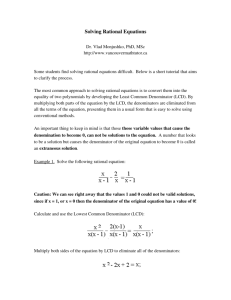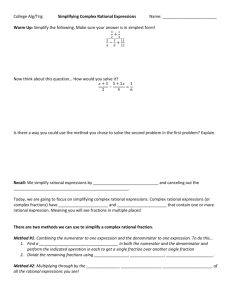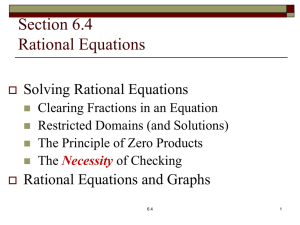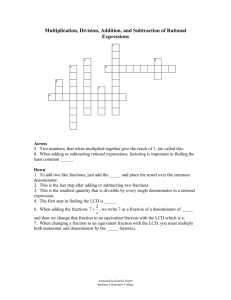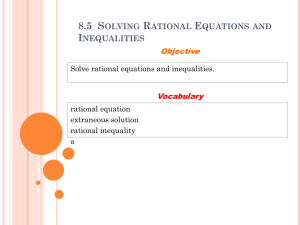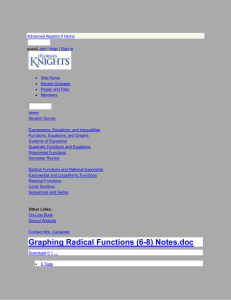Integrated Advanced Algebra
advertisement
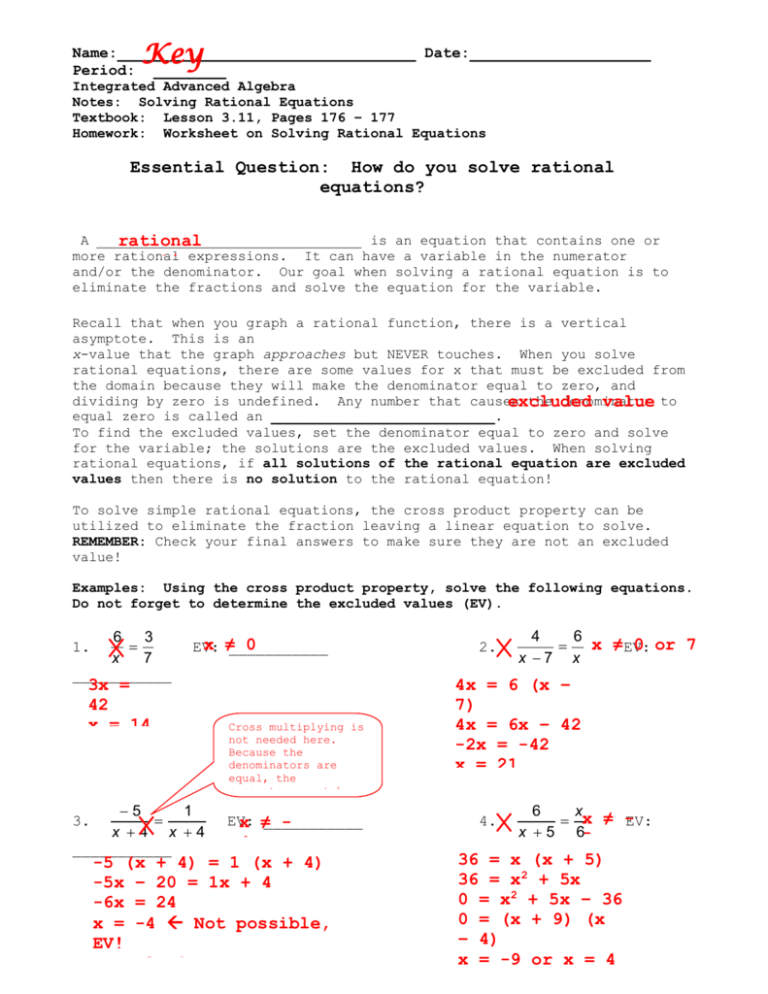
Key Name:_________________________________ Date:____________________ Period: ________ Integrated Advanced Algebra Notes: Solving Rational Equations Textbook: Lesson 3.11, Pages 176 – 177 Homework: Worksheet on Solving Rational Equations Essential Question: How do you solve rational equations? A ________________________________ is an equation that contains one or rational more rational expressions. It can have a variable in the numerator equation and/or the denominator. Our goal when solving a rational equation is to eliminate the fractions and solve the equation for the variable. Recall that when you graph a rational function, there is a vertical asymptote. This is an x-value that the graph approaches but NEVER touches. When you solve rational equations, there are some values for x that must be excluded from the domain because they will make the denominator equal to zero, and dividing by zero is undefined. Any number that causes the denominator excluded value to equal zero is called an ___________________________. To find the excluded values, set the denominator equal to zero and solve for the variable; the solutions are the excluded values. When solving rational equations, if all solutions of the rational equation are excluded values then there is no solution to the rational equation! To solve simple rational equations, the cross product property can be utilized to eliminate the fraction leaving a linear equation to solve. REMEMBER: Check your final answers to make sure they are not an excluded value! Examples: Using the cross product property, solve the following equations. Do not forget to determine the excluded values (EV). 6 3 x 7 ___________ 1. x ≠___________ 0 EV: 3x = 42 x = 14 5 1 x 4 x 4 ___________ 3. Cross multiplying is not needed here. Because the denominators are equal, the numerators must be equal as well! EV: x ≠___________ - 4 -5 (x + 4) = 1 (x + 4) -5x – 20 = 1x + 4 -6x = 24 x = -4 Not possible, EV! No Solution 2. 4 6 x ≠EV: 0 or 7 x 7 x 4x = 6 (x – 7) 4x = 6x – 42 -2x = -42 x = 21 4. 6 x EV: x ≠ x 5 65 36 = x (x + 5) 36 = x2 + 5x 0 = x2 + 5x – 36 0 = (x + 9) (x – 4) x = -9 or x = 4 Name:_________________________________ Date:____________________ Period: ________ Sometimes, you will have more than one rational expression on one or both sides of the equation. When this situation occurs the cross product property will not apply. You must find the LCD (least common denominator). By multiplying the entire equation by the LCD, the fractions are eliminated and you are left with an equation to simplify and solve. Examples: Multiply through by the LCD to solve the following equations. Do not forget to determine the excluded values (EV). 2 8 3 x x EV: __________ 5. x ≠___________ 0 EV: ( 2 ) + x (-3) = x x 8 ) x (x – 3) ( 3) ( Examples: Solve the rational equation. excluded values (EV). 8 x x 8 x 2 __________ Do not forget to determine the x ≠___________ -8 or EV: -2 8 (x + 2) = x (x + 8) 8x + 16 = x2 + 8x 0 = x2 – 16 16 = x2 ±4 = x 3x 10 2 x 1 x 1 ____________ 9. 8. 1) ( LCD is (x + 2) (x + 2) ( 2) ( 3x ) + (x – 1) (-2) = (x – x 1 3x – 2x + 2 = 10 x + 2 = 10 4 ) + (x + 2) (3) = (x + x 2 9 ) x 2 4 + 3x + 6 = 9 3x + 10 = 9 3x = -1 x = -1/3 EV: x ≠___________ 1 10 ) x 1 4 9 x ≠ EV: 3 x 2 x 2 2 LCD is (x – 1) (x – 1) ( x 1 ) x 3 7x ) + (x – 3) (4) = (x – x 3 7x + 4x – 12 = x + 1 11x – 12 = x + 1 10x = 13 x = 1.3 2 – 3x = 8 -3x = 6 x = -2 7. 7x x 1 4x ≠ 3 x 3 x 3 LCD is (x – 3) LCD is x x ( 6. 10. 12 7 -2 or x ≠ EV: x 2 x 33 12 (x – 3) = 7 (x + 2) 12x – 36 = 7x + 14 5x = 50 x = 10 Name:_________________________________ Date:____________________ Period: ________ Integrated Advanced Algebra Homework Worksheet: Solving Rational Equations Solve the rational equation. values (EV). 3 2 x x 4 ___________ 1. Do not forget to determine the excluded x ≠___________ 0 or EV: 4 3 (x + 4) = 2x 3x + 12 = 2x x = -12 3 4 5 x 2 x 2 ___________ 3. 2) ( 5. x ≠___________ EV: 2 3 ) + (x + 2) (5) = (x + x 2 4 ) x 2 3 + 5x + 10 = 4 5x + 13 = 4 5x = -9 x =2x -9/5 12 3 x 4 ___________ x 4 x ≠___________ EV: 4 LCD is (x + 4) (x + 4) ( 4) ( 12 ) x 4 x 1 x 2 ≠ -2/5 EV: 2x 5 xor 0 (x + 1) x = 2 (2x + 5) x2 + 1x = 4x + 10 x2 – 3x – 10 = 0 (x – 5) (x + 2) = 0 x = 5 or x = -2 LCD is (x + 2) (x + 2) ( 2. 2x ) + (x + 4) (-3) = (x + x 4 2x – 3x – 12 = -12 -x = 0 x = 0 4. 6 x x ≠ 3 EV: x 3 18 6 (18) = x (x – 3) 108 = x2 – 3x 0 = x2 – 3x – 108 0 = (x – 12) (x + 9) x = 12 or x= -9 6. 14 x ≠ 22 or EV: 0 2x x 14 (x) = 2 (2 – x) 14x = 4 – 2x 16x = 4 x = 4/16 x = 1/4 Name:_________________________________ Date:____________________ Period: ________ 2 6 2 x 4 x 4 EV: __________ 7. x ≠ ___________ 4 EV: LCD is (x – 4) (x – 4) ( 4) ( 2 ) + (x – 4) (2) = (x – x 4 6 ) x 4 2 + 2x – 8 = 6 2x – 6 = 6 2x = 12 x = 6 8. x 2 6 x x ≠ x 1 x 1 1 LCD is (x + 1) (x + 1) ( + 4) ( x 0 8 x + = = = x 2 ) + (x + 1) (-x) = (x x 1 6 ) x 1 2 – x2 – x = -6 x2 – 8 x2 ±2√2
